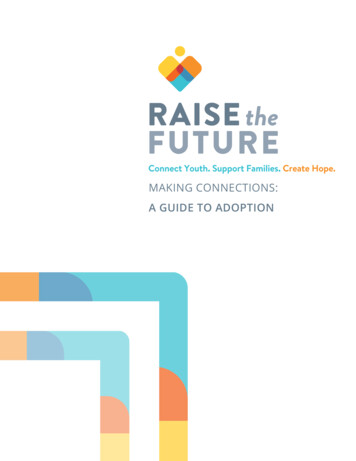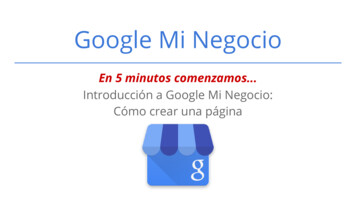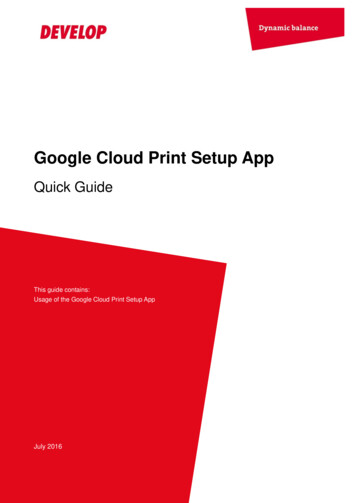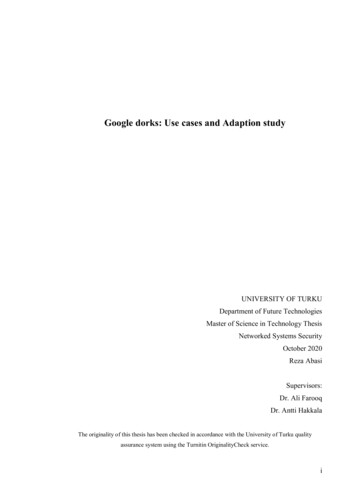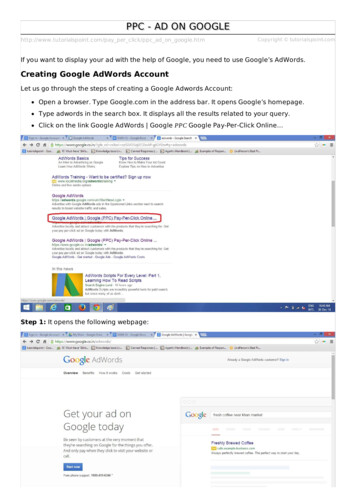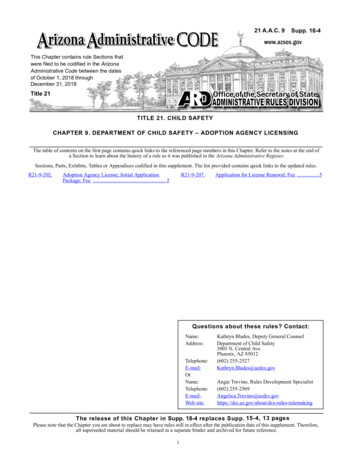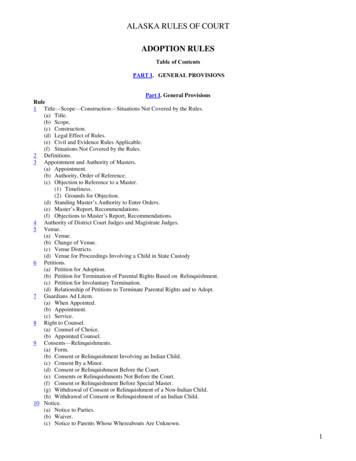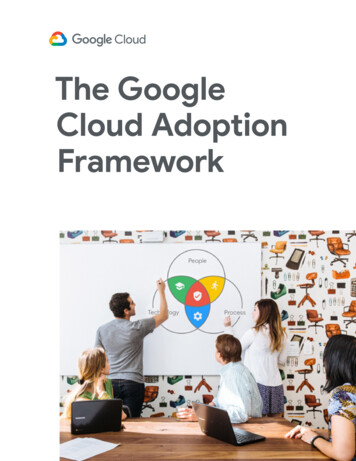
Transcription
The GoogleCloud AdoptionFramework
Table of ContentsPart 1: Executive summaryA unified approach to the cloud . . . . . . . . . . . . . . . . . . . . . . . . . . . . . . . 2Four themes, three phasesThe Cloud Maturity ScaleFine-tuning your direction with epicsThe Google Cloud Adoption FrameworkGetting started. . . . . . . . . . . . . . . . . . . . . . . . . . . . . . . . . . . . . . . . . . . . . . . 8Part 2: Technical deep-diveIntroduction. . . . . . . . . . . . . . . . . . . . . . . . . . . . . . . . . . . . . . . . . . . . . . . . . 11The cloud maturity phases . . . . . . . . . . . . . . . . . . . . . . . . . . . . . . . . . . . 11Tactical maturityStrategic maturityTransformational maturityThe cloud maturity scale. . . . . . . . . . . . . . . . . . . . . . . . . . . . . . . . . . . . . 14LearnLeadScaleSecureThe epics . . . . . . . . . . . . . . . . . . . . . . . . . . . . . . . . . . . . . . . . . . . . . . . . . . . 27
Google Cloud Adoption FrameworkPart 1:ExecutiveSummary
2A unified approach to the cloudMoving to the cloud offers enormous benefits for businesses. Yetthere are risks as well. The challenge is multidimensional, with farreaching implications not just for the solutions that will run in thecloud, but also for the technologies that support them, the peoplewho need to implement them, and the processes that govern them.The rubric of people, process, and technology is a familiar one. Buthow do you harness it to move forward?As one of the earliest organizations to operate entirely in the cloud,Google has been spearheading projects for years that address thisvery issue — from leadership and people management best practiceslike re:Work, to engineering-driven software operations methodologies like Site Reliability Engineering, to zero-trust security models likeBeyondCorp. It is from work such as this that we’ve developed astreamlined framework for adopting the cloud.The Google Cloud Adoption Framework builds a structure on therubric of people, process, and technology that you can work with,providing a solid assessment of where you are in your journey to thecloud and actionable programs that get you to where you want to be.It’s informed by Google’s own evolution in the cloud and many yearsof experience helping customers.You can use the framework yourself to make an assessment of yourorganization’s readiness for the cloud and what you’ll need to do to fillin the gaps and develop new competencies. If you’d like a partner onthat journey, we’re here for you. We can help you develop a solidstrategy and guide you through the process so that you’re capitalizingon all that the cloud has to offer, driving the innovation you need tostreamline internal operations and scale your brand.But whether or not we accompany you on the journey, our frameworkcan help you find your way, from your first project all the way tobecoming a cloud-first organization. Take it, use it, and move forwardto the cloud with confidence.You can use theframework yourself tomake an assessmentof your organization'sreadiness for the cloud
3Four themes, three phasesTo truly develop a cloud-first organization, there are four realms (we call them themes1) you will need toexcel in — whatever your business objectives. These four themes define the foundation of cloudreadiness:Learn: The quality and scale of the learning programs you have in place to upskill yourtechnical teams, and your ability to augment your IT staff with experienced partners.Who is engaged? How widespread is that engagement? How concerted is the effort?How effective are the results?Lead: The extent to which IT teams are supported by a mandate from leadership tomigrate to cloud, and the degree to which the teams themselves are cross-functional,collaborative, and self-motivated. How are the teams structured? Have they gotexecutive sponsorship? How are cloud projects budgeted, governed, assessed?Scale: The extent to which you use cloud-native services that reduce operational overhead and automate manual processes and policies. How are cloud-based servicesprovisioned? How is capacity for workloads allocated? How are application updatesmanaged?Secure: The capability to protect your services from unauthorized and inappropriateaccess with a multilayered, identity-centric security model. Dependent also on theadvanced maturity of the other three themes. What controls are in place? What technologies used? What strategies govern the whole?1See Stories versus Themes versus Epics to learn more about agile taxonomy.
4Your readiness for success in the cloud is determined by your current business practices in each of thesefour themes. For each theme, those practices will fall into one of the following phases:Tactical: Individual workloads are in place, but no coherent plan encompassing all ofthem with a strategy for building out to the future.The focus is on reducing the cost of discrete systems and on getting to the cloud withminimal disruption. The wins are quick, but there is no provision for scale.Strategic: A broader vision governs individual workloads, which are designed and developed with an eye to future needs and scale.You have begun to embrace change, and the people and processes portion of the equation are now involved. IT teams are both efficient and effective, increasing the value ofharnessing the cloud for your business operations.Transformational: With cloud operations functioning smoothly, you’ve turned yourattention to integrating the data and insights garnered from working now in the cloud.Existing data is transparently shared. New data is collected and analyzed. The predictiveand prescriptive analytics of machine learning applied. Your people and processes arebeing transformed, which further supports the technological changes. IT is no longer acost center, but has become instead a partner to the business.In the tactical phase, you are reducing costs with a quick return on investment and little disruption to yourIT organization. This is a short-term goal. In the strategic phase, you increase the value delivered by yourIT organization by streamlining operations to be both more efficient and more effective. This is a midterm goal. In the transformational phase, your IT organization becomes an engine of innovation, makingit a partner to the business. This is a long-term goal.
5The Cloud Maturity ScaleWhen you evaluate the four themes in terms of the three phases, you get the Cloud Maturity Scale.TacticalLearnLeadScaleTeams by function,heroic projectmanagerChange is slow andrisky, ops heavySecureFear of publicinternet, but trust inprivate networkStrategicNewcross-functionalcloud teamTemplates ensuregood governancewithout manualreviewCentral identity,hybrid networkTransformationalCross-functionalfeature teams,greater autonomyTrust only the rightpeople, devices,and servicesIn each of the themes, you can see what happens when you move from adopting new technologiesad hoc, to working with them more and more strategically across the organization — which naturallymeans deeper, more comprehensive, and more consistent training for your people, which in turnmeans streamlined and updated processes, which in its turn drives innovation. The whole organizationgradually transforms.When you are fully invested in the cloud, fully harnessing its capabilities, you are then a cloud-firstorganization.
6Fine-tuning your direction with epicsOnce you’ve determined where you are in your cloud maturity journey, it’s time to move forward. To scopeand structure your program of cloud adoption, you will implement a number of workstreams (which wecall epics2). The epics are defined so that they do not overlap, they are aligned to manageable groups ofstakeholders, and they can be further broken down into individual user stories, making your programplanning easier.Here’s a look at those epics within the familiar rubric of people, technology, and process. If you can doonly a subset of the epics, focus on the ones in the colored segments. Those are the epics that align withLearn, Lead, Scale, and Secure; and so those are the epics that will define your journey tosuccessful cloud adoption.PeoplePeople UpskillingNetworkingTechnologyResource Mgmt .SponsorshipIdentity &AccessTeamworkCost ControlData Mgmt .ProcessArchitectureInfra as CodeIncident Mgmt .CI/CDInstrumentation2See Stories versus Themes versus Epics to learn more about agile taxonomy.
7The Google Cloud Adoption FrameworkAnd those are the three components of the framework Google Cloud uses to guide customers seamlessly to the cloud: the three maturity phases applied to the four cloud adoption themes, and the epics.With the Cloud Maturity Scale, you determine where you are in your journey to the cloud. With the epics,you devise a way to get to where you’d like to be. You can use the maturity scale and the epics with anycloud provider, of course: the framework is technology agnostic. But if you’d like to ensure success, youmight consider engaging Google Cloud to be your guide.Working with a Technical Account Manager (TAM), you can perform a high-level assessment of yourorganization’s cloud maturity, which will tell you how to prioritize your training and change managementprograms, your partner relationships, your cloud operating model, and your secure accountconfiguration.The Adoption Framework streamlines your journey to successfully adopting the cloud. Working withinthe framework, a TAM can guide you along that journey, from your first cloud project to becoming a fullycloud-first Transformational
8Getting startedThe details in the technical deep-dive spell out the foundation formoving forward, but at a high level, the process looks like this.Assess your current cloud maturityIntroduce your stakeholders to the four cloud adoption themes, thatis, to your team’s ability to continuously learn, effectively lead, efficiently scale, and comprehensively secure in the cloud. Use thesummary tables provided for each theme in the technical deep-diveas a reference for discussion. Consider assessing all attributes in theform of a survey for stakeholders to fill out.TrainingProgramPeopleAsk yourself how far you want to goDiscuss within your team which stage of cloud maturity your businessshould aim for. Chances are that, to begin with, stakeholders acrossdifferent levels of your IT organization will not be aligned and thatthey’ll point out that the incentives vs. risks don’t yet match theiraspirations. Consider focusing on tactical objectives in the near termto serve as a stepping stone for later strategic or long-term transformational objectives.Change ManagementProgramPlan your cloud adoption programTake action on any cloud adoption epic for which you’ve identified agap and pay particular attention to the epics that live inside the cloudadoption themes. Keep in mind that your actions are a means to oneof four ends: developing a training program, devising your changemanagement program, designing your cloud operating model, orsecurely setting up your Google Cloud Platform (GCP) account.ProcessCloudOperating ModelTechnologySecureAccount Setup
9Find the right workloadsEven the greatest degree of cloud maturity is inconsequential withoutcritical workloads in production in the cloud. Start with simple,non-business-critical applications to develop the muscles andconfidence in your cloud competencies. As you develop yourorganization’s abilities to learn, to lead, to scale, and to secure, youshould also be ready to tackle more complex and critical applicationsin lockstep.Should you begin with workloads? Or with a cloud operating model? Astartup company may have a bias toward action, putting workloadsinto production quickly and assuming greater operational risk inreturn. An enterprise with a top-down cloud adoption approach mayprefer to first invest in a cloud operating model and playbooks beforeany workloads are deployed in the cloud.Which workloads and when are up to you.As you develop yourorganization’sabilities to learn, tolead, to scale, and tosecure, you shouldalso be ready totackle more complexand critical applications in lockstep
Google Cloud Adoption FrameworkPart 2:Technicaldeep-dive
11IntroductionThe move to the cloud can be arduous — unless you plan well from the beginning.The Adoption Framework helps you with that planning. The framework comprises the Cloud MaturityScale, which enables you to analyze where you are now in your journey to the cloud, and the epics, whichhelp you organize how you will get to where you’d like to be.The Cloud Maturity Scale measures your organization’s readiness for the cloud by considering yourcurrent business practices (which it classifies into one of three phases) across four themes. The epicschunk the actions you will need to take into discrete, and discretely measurable, workloads that map tothe same four themes.The Adoption Framework is derived from Google’s experience of helping hundreds of customers maketheir way to the cloud. By working within the framework, you can ensure that you are making the rightchoices, both now for current workloads and with an eye to the future, so that the investments you maketoday continue to serve you well as you move more and more operations to the cloud. By working withinthe framework, in other words, you make the most of your resources from that first workload on.The cloud maturity phasesThe Cloud Maturity Scale is based upon the three phases of cloud maturity, as they apply to the cloudadoption capabilities (that is, the themes) you will need to master. These three phases apply to anybusiness’s journey to the cloud, and they are defined by the business practices current at the time:TacticalStrategicTransformational
12Businesses that make the most of the cloud — businesses that usethe cloud to drive innovation — are businesses that work towards thetransformational phase, which is a long-term goal. But you willachieve short-term successes at the tactical and mid-term successesat the strategic phases as well, and in fact each of those two phasesis necessary and useful.Looking more closely at those phases makes clearer the benefits ofeach, and the way that one phase prepares the way for the next.Tactical maturityAs an organizationwith tactical cloudobjectives, you look toexecute projects withminimal changeTactical cloud adoption can achieve the short-term business objectiveof optimizing cost within your existing IT solutions, for example, byoptimizing heavily underutilized compute and storage resources or byremoving the operational overhead and delay of manually procuringand provisioning resources.As an organization with tactical cloud objectives, you look to executeprojects with minimal change to your IT teams (people), your applications and software tools (technology), and your operating model(process). This is an important phase in the journey to making themost of the cloud, and it should not be undervalued.The benefits of a tactical degree of cloud maturity are contingent onthe outcome of your total cost of ownership (TCO) analysis3. Shouldyou anticipate only marginal cost benefits from this approach, youmay regard your cloud adoption merely as a lateral move and betempted to aim straight for the strategic phase. Be cautious ofmaking this leap if your business does not already have firsthandexperience running production use cases in the cloud today. Just asthere is a cost to moving to cloud, there is also great value in thelessons learned through experimentation. The tactical phase lays thefoundation for the work you will do in the strategic phase.3As discussed in McKinsey: Cloud adoption to accelerate IT modernization and True Cloud Justification: Moving Beyond TCO Savings.
13Strategic maturityA strategic degree of cloud maturity is sufficient to achieve the midterm business objective of increasing value delivered by your ITorganization. This level is achieved by noticeably improving the efficacy and efficiency with which IT teams develop and operatesoftware solutions, as well as by modernizing the architectures ofthose solutions to take advantage of cloud-native services andplatforms.A strategic degree ofcloud maturityachieves the mid-termbusiness objective ofincreasing valuedelivered by your ITorganizationAs an organization with strategic cloud objectives, you will likelyimplement some degree of change to your IT teams (people), yourapplications and software tools (technology), and your operatingmodel (process). This change can be limited to an isolated part ofyour IT organization and still be effective, providing a blueprint andearly success stories that can be expanded when the IT organizationis ready for comprehensive, transformational change.Transformational maturityA transformational degree of cloud maturity is necessary to achievethe long-term business objective of reforming your IT into a sustainable engine of innovation that powers your business transformation.Rather than a cost center, IT is now a partner to the business.An innovation center’s key contribution to the business is the dataand insights derived from the transparent and thoughtful sharing ofexisting data, the collection and analysis of new data (for example,sentiment, image, voice), and the application of predictive and prescriptive analytics (machine learning). You should also apply thisdata-driven approach to your IT organization itself, iterating on newfeatures in a truly agile fashion, accelerating the speed at which youcan deliver innovation.As an organization with transformational cloud objectives, you facethe prospect of comprehensively reorganizing your IT organization.Concretely, this means facilitating greater lateral awareness andknowledge exchange and empowering individual contributors orproject teams to make more decisionsAs an organizationwith transformationalcloud objectives, youface the prospect ofcomprehensivelyreorganizing your IT
14autonomously, measured against agreed-upon service-level objectives (SLOs). You take a cloud-first position, in which cloud-basedservices and best practices are the new norm. To support that, youreward experimentation and individual initiative, even in the event offailure, and understand how to reasonably price the value of what isbeing learned against the cost incurred by your cloud hosting bill.The Cloud Maturity ScaleBringing the three phases of cloud maturity to bear on the fourthemes of cloud adoption results in the Cloud Maturity Scale, a powerful tool for assessing where you are in your journey to the cloud. Itdoes this by measuring your current practices against the knownfoundations for success. If you make the investment into these foundations from the start, you will be supporting yourorganization’s ability to support increasingly ambitious businessobjectives, complex software solutions, and cloud-nativearchitectures.In other words, you will be supporting your organization’s journey totransformational cloud maturity. At this phase, your organization willhave mastered the ability to continuously learn, to effectively lead, toefficiently scale, and to comprehensively secure.Getting to that point involves planning and successes at the twophases preceding. To ensure you’re focusing your efforts on the mostimpactful areas, you’ll want to understand the four themes in depth,with attributes illustrating how each evolves over time across thetactical, strategic, and transformational phases.If you make theinvestment intothese foundationsfrom the start, youwill be supportingyour organization’sability to supportincreasinglyambitious businessobjectives
15LearnCloud Adoption Epics: Upskilling, External ExperienceYour organization’s ability to continuously learn is determined by your efforts toupskill your IT staff while also taking advantage of the experiences shared bythird-party contractors and partners. This two-pronged approach ensures thatyou apply cloud computing best practices idiomatically to Google Cloud Platform(or any other public cloud provider), tailored to your business needs and withouthaving to climb the steep learning curve of doing things for the first time.Your staff will be more familiar with your organization’s unique idiosyncrasiesand understand its technical and cultural nuances, while supporting thirdparties will have the experience of having completed multiple prior cloudmigrations across a broad spectrum of customer solutions.TRANSFORMATIONALSTRATEGICTACTICAL
16Tactical maturityUpskilling is on a best-effort basis, reliant on individual selfmotivation and free educational resources like online documentationand YouTube.Third-party contractors and partners are relied upon to deliver essential work required to achieve the objectives set out by the business.They typically enjoy wide-ranging and ongoing privileged access toyour organization’s cloud estate and serve as a first point of escalation in the event of a technical question or an operational incident.You expect to be able to achieve tactical objectives with the IT staffyou have and are not taking action to hire new staff with prior cloudexperience.Strategic maturityUpskilling is program managed and offered to any IT role who isdirectly or indirectly responsible for contributing to a successful cloudadoption. A learning plan has been published, training classes (onlineor offline) are offered on a regular basis, and achieving formal certification is encouraged and budgeted for.Third-party contractors and partners provide subject matter expertiseto fill the IT staff’s remaining knowledge gaps or where the topic is sonarrow and deep that it would be unreasonable to expect your IT staffto upskill to that level. These external parties serve as a second-tierpoint of escalation in the event of a technical question or operationalincident that cannot be answered or resolved internally within your ITstaff. As such, they will typically have moderated access to the organization’s cloud estate and be authorized (and audited) to escalate theirprivileges in break-glass scenarios that require quick and determinedintervention.You are actively opening new roles and are hiring for people with priorcloud experience to complement the IT staff as it upskills itself oncloud computing best practices.Supporting thirdparties will have theexperience of havingcompleted multipleprior cloud migrationsacross a broadspectrum of customersolutions
17Each IT staff member is given a GCP sandbox project and a limited budget for them to experiment withand test new ideas.Transformational maturityUpskilling is continuous and collaborative. In addition to a regular formal training program, IT teams andindividual contributors host regular hackathons and tech talks to maximize knowledge sharing. Goingone step further, IT staff are encouraged to demonstrate thought leadership to the industry throughpublic blog articles and public speaking. This outreach serves a double function of challenging staff tostretch themselves and also to attract new talent to be hired.You have reviewed and, where needed, redefined all roles and responsibilities to reflect the new requirements of a cloud-first IT organization.Third-party contractors and partners serve primarily as staff augmentation with no privileged accessand very few areas of exclusive knowledge. Most technical questions can be answered internally, and allincident response playbooks can be executed entirely in-house.
18LeadCloud Adoption Epics: Sponsorship, TeamworkThe effectiveness of your organization’s cloud adoption is determined by thevisibility and value of the mandate issued top-down from your sponsors (whichinclude C-level executives as well as middle management and team leaders) andthe motivational momentum generated bottom-up from your teams’ crossfunctional collaboration. These two counterparts together are responsible forclearly articulating objectives, making informed decisions, and executing them inconcert with multiple functions.Sponsors control which resources are allocated to your organization’s cloudadoption efforts and bring stakeholders from different business functionsand reporting lines together. However, they must ultimately rely on an agileand cross-functional group of cloud early adopters to practically implement theirstrategy.TACTICALSTRATEGICTRANSFORMATIONAL
19Tactical maturitySponsorship is limited to senior management from or for one line ofbusiness. Their primary contribution is delivering the mandate (“signing off”) and passing it down their reporting line to be executed upon.Sponsors only get actively involved as a final point of escalation whenprogress is otherwise hampered.Cloud adoption progress is driven by individual contributors with apersonal interest in cloud computing for their solution(s). The abilityfor early adopters to collaborate with other IT roles is subject to thefriction of the incumbent org structure and reporting lines.Because the scope is limited to the project or line of business that thisteam of early adopters is aligned with — and must operate within thatbudget — their output will not be embedded with central IT.Depending on the perspective, the outcome is either a “minimumviable cloud” or “cloud shadow IT.”Strategic maturitySponsorship extends up to the C-level. Each manager in the reportingline has clearly defined objectives and KPIs that support the organization’s cloud adoption. Sponsors’ key contributions include activelyreaching out horizontally to other IT or business functions to clear thecritical path of roadblocks and visibly and continuously championingthe journey.Performance indicators prioritize traditional IT service-levelobjectives over the speed of experimentation, innovation, andrecovery from failure.Cloud adoption progress is driven by a dedicated cross-functionalteam (Center of Excellence) of advocates, working across projectboundaries. All critical IT roles inside this COE are filled, for example,application architect, software or data engineer, networking engineer,and identity/directory admin, across operations, information security,and finance. Team members are committed full-time or part-time, andtheir job title and their personal performance indicators are updatedto reflect their new responsibilities.Sponsors mustultimately rely on anagile and crossfunctional group ofcloud early adoptersto practicallyimplement theirstrategy
20Cloud adoption may also be complemented by a dedicated technical project manager who is familiarwith the IT organization, the stakeholders, and the technology landscape.Transformational maturitySponsorship is comprehensive across the entire C-level to include marketing, finance, operations, HR,and more, and extends down to all levels of management. They comprehensively and consistently setthe tone for a culture of experimentation and innovation within teams. Error budgets for software services are accepted and understood at the highest level (CEO), and a culture of blameless postmortems isfostered throughout the IT organization.Project teams operate in an environment of transparency and open information sharing and enjoyenough decision-making autonomy to be able to experiment ad hoc without having to ask for permissionor having to wait for resources to be provisioned. (Data governance and cost control are now a functionof automation, not manual managerial process.) Failures are celebrated for the valuable lessons that theteam has learned and will be shared with the wider business for posterity. An individual’s mistake isinterpreted as a collective or systematic failure that must be addressed as a whole, not by reprimandingthe individual.
21ScaleCloud Adoption Epics: Architecture, Continuous Integration and Delivery(CI/CD), Infrastructure as CodeYour organization’s ability to scale in the cloud is determined by the extent towhich you abstract away your infrastructure with managed and serverlesscloud services, as well as the quality of your CI/CD process chain and theprogrammable infrastructure code that runs through it.Because everything is managed via an API, automation can pay greaterdividends in the cloud than in any other environment. Not only does it reducehuman toil and serve as automatic documentation, it is also instrumental inmaking change low risk and frequent -- the key ingredient for innovation.TACTICALAll cloud resources areprovisioned manually .Solutions run in long-livedVMs, and OS must bemaintained .Changes are reviewedmanually, are high risk, andare deployed infrequentlyand manually .STRATEGICProject foundations areprovisioned from templates .Solutions run in immutableVMs or containers, andaccess is locked down .Changes are testedautomatically, are medium risk,and are deployed manually .TRANSFORMATIONAL
22Tactical maturityUse of managed or serverless cloud services is limited. Instead, acontinued reliance on self-managed, long-lived virtual machines (VMs)provides a familiar computing platform at the risk of entropy (“configdrift”), making consistent and secure operations increasingly hard overtime. Because there is more to be managed, there is also more to bemeasured, increasing the burden of collecting quality, high-frequencyevents and metrics.Changes to application code and environment configuration arereviewed and controlled manually, for example, by a change advisoryboard. They are often considered high risk and deployed infrequently,measured in weeks or even months.The provisioning of cloud resources is performed manually via theGCP Web Console or command-line interface (CLI). Infrastructureautomation tools like Deployment Manager or Hashicorp’s Terraf
The Google Cloud Adoption Framework And those are the three components of the framework Google Cloud uses to guide customers seam - lessly to the cloud: the three maturity phases applied to the four cloud adoption themes, and the epics. With the Cloud Maturity Scale, you determine where you are in your journey to the cloud. With the epics,



